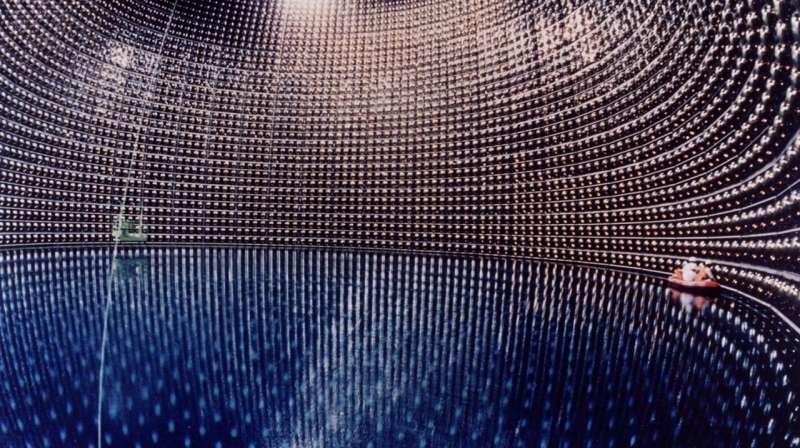A novel approach to detecting highly interactive dark matter within neutrino detectors

This article has been reviewed according to Science X's editorial process and policies. Editors have highlighted the following attributes while ensuring the content's credibility:
- fact-checked
- peer-reviewed publication
- trusted source
- proofread
by Ingrid Fadelli, Phys.org
Physicists worldwide are trying to detect dark matter (DM) particles and their interactions with visible matter using various strategies and detectors. As these particles do not emit, reflect or absorb light, they have so far proved to be very difficult to observe, particularly using common experimental methods.
Researchers at TRIUMF, University of Minnesota, University of California Berkeley and Stanford University recently proposed a new approach that could help to detect these mysterious particles, unexplained by the standard model. This approach, introduced in a paper published in Physical Review Letters, aims to detect signals hinting at the annihilation of dark matter to visible matter inside large neutrino detectors.
'Earth-bound DM (DM particles that are being trapped in the Earth via collisions with Earth's constituents) that interacts sufficiently strongly with the ordinary baryonic matter can have a tantalizingly large density, almost 15 orders of magnitude larger than the Galactic DM density (~ 0.3 GeV/cm3),' Anupam Ray, one of the researchers who carried out the study, told Phys.org.
'Now the big question was: how to detect such DM particles which are quite abundant in the Earth-volume? Since their kinetic energy is tiny (~ 0.03 eV), their detection in the traditional direct detection experiments is almost impossible as these experiments are not sensitive to such a low energy deposition. So, we were thinking of novel ways to detect such DM particles.'
Instead of searching for signals hinting at the scattering of DM particles, as most direct detection efforts have done so far, Ray and his colleagues suggested looking at their annihilation signals. These are signals that occur when DM are annihilated, or in other words when they collide with other particles and are obliterated, releasing energy in the process.
In contrast with scattering signals, annihilation signals are not limited to tiny amounts of kinetic energy, thus they could potentially be easier to look for and detect. As Earth-bound DM particles are theorized to be abundant, the researchers suggested looking for them by searching for signals hinting at their annihilation inside large-volume neutrino detectors, such as Super-Kamiokande. This is a large-scale Cherenkov detector located under Mount Ikeno in Japan, which is being used to study neutrinos originating from the sun, supernovae, the atmosphere and other sources.
'Earth-bound DMs that interact strongly with ordinary baryonic matter are copiously present inside any large volume neutrino detectors, such as Super-Kamiokande,' Ray explained. 'If they annihilate inside the Super-Kamiokande fiducial volume, it could induce observable signatures. Super-K can easily search these annihilation products, and from these searches, one could provide unprecedented sensitivity to DM parameters. It is important to stress that, even if these strongly interacting Earth-bound DM particles make up a very fraction of the whole DM density (there is no reason to believe that DM is made up of a single species), our proposed method can provide world-leading sensitivity to the DM parameters.'
The recent work by this team of researchers introduces a new method that could help to probe Earth-bound strongly interacting DM particles, which are theorized to be highly abundant and yet have so far been very difficult to observe. Even if these specific particles only make up a tiny fraction of the present-day DM density, this new method could work remarkably well and could thus contribute to the ongoing search for DM.
'We now want to explore the neutrino signatures from strongly interacting Earth-bound DM,' Ray added. 'In this study, we are not sensitive to a relatively heavy DM mass (say DM mass of 10 GeV or more). Because, as the DM gets heavier, they concentrate towards the center of the Earth, and as a consequence, their number density inside Super-Kamiokande volume significantly depleted, resulting in a negligible signal. However, by using the neutrino signal, we are hopeful to probe the heavy DM parameter space.'
Journal information: Physical Review Letters
© 2023 Science X Network




